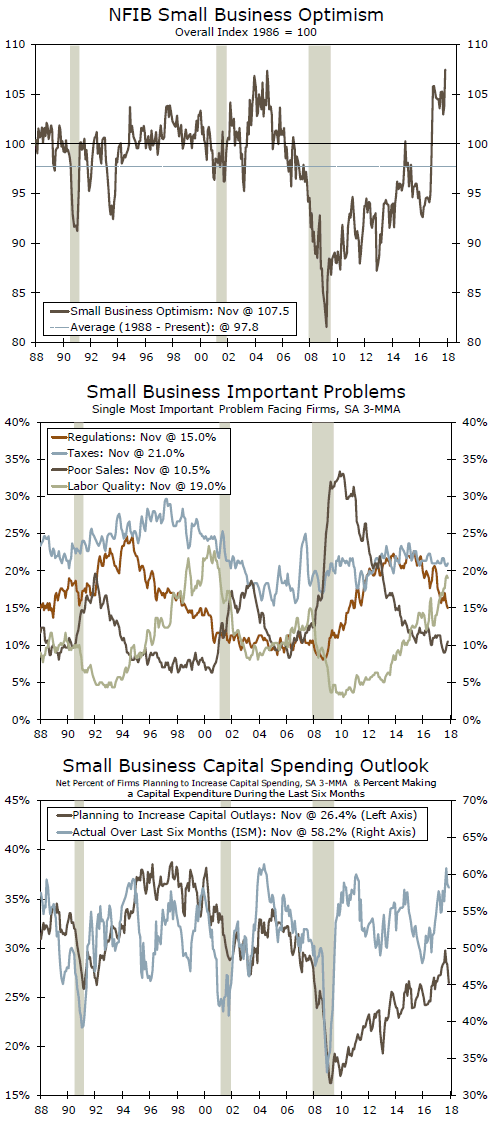Small Business Optimism jumped 3.7 points in November to 107.5, with 8 of the 10 components posting increases. The gain brought Small Business Optimism to its highest level in 34 years.
Small Business Owners Are Looking Forward to Tax Reform
The improved prospects of meaningful tax reform have provided a significant boost to small business confidence. The National Federation of Independent Business (NFIB) Index of Small Business Optimism rose 3.7 points in November to 107.5, bringing the closely watched index to its second-highest level in its 44-year history. Eight of the 10 components of the survey increased during the month, with most of the gain coming from a 16-point jump in Expected Business Conditions and a 13-point rise in Sales Expectations. The improvement in small business confidence is meaningful and suggests employment growth and business fixed investment should maintain strong momentum going into the new year.
Taxes and regulation have consistently ranked as two of the most important problems facing small business owners. A great deal of progress has already been made at reducing the impact of existing regulations and slowing the pace of new regulations, which is one of the reasons why small business confidence had improved as much as it had before the tax debate began. Now, with the prospects of meaningful tax reform seemingly within reach, small business confidence has risen even further.
Business owners’ focus on taxes and regulations is understandable. Small business owners tend to wear many hats. Business owners often simultaneously serve as the chief operating officer, head of human resources, chief compliance officer and top sales person. The more time business owners devote to figuring out how to comply with regulations or minimize their taxes, the less time they have to grow their business.
With regulations being scaled back and taxes set to be cut, more business owners report that now is a good time to grow their business. The proportion of firms stating that now is a good time to expand rose 4 points to 27 percent in November, which is back to its high for this cycle. While plans to expand increased, plans to make additional capital outlays in the next six months slipped 1 point in November to a still solid 26 percent. Plans to increase employment rose 6 points in November.
While hiring plans rose, actual hiring moderated. Thirteen percent of firms reported hiring workers, while 10 percent said they reduced employment. Fifty-two percent of business owners either hired workers or tried to hire workers, but 44 percent reported they had few or no qualified applicants. Difficulty finding qualified workers has become a more critical problem for business owners, particularly for construction firms and manufacturers.
The improvement in Small Business Optimism suggests tax reform may provide a more meaningful boost to economic growth in 2018. Small Business Optimism picked up well ahead of the economy as a whole in 2017, and major changes in the index have proven to be a reliable leading indicator, particularly for capital spending and employment.














